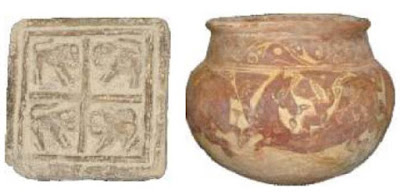- Get link
- X
- Other Apps
Posted by
Shashank shahi
on
- Get link
- X
- Other Apps
but rarely survive. The most famous example in wood being the intricately carved 'doors of Somnaths, taken from Mahmud's tomb in Ghazni and now in the Red fort in Agra, India. It is also important to remember that although the artists of the Ghaznavid Empire are what Ghazni is remembered for today, the pre-Islamic Buddhist period in the region also offers many earlier examples of skilled art.
The Buddhist art dating from the 2nd - 5th century CE is often called the art of Gandhara (a mixture of art styles from Buddhist India, Graeco-Bactria and Late Roman Empire) and was famous for its sculptures made in stucco (a type of heavy plaster), clay or schist (a type of shiny rock). Ghaznavid architecture also shows us how art and decoration employed many different materials to make a building, tomb or a monument more beautiful or noticeable. Marble was extensively used and magnificent examples of the variety of designs and motifs employed can be seen from the palace of Massud Ill. Over 512 carved marble panels were discovered, displaying all manner of designs from 'Turkish dancing girls' and men on horseback to lions, elephants and floral scrolls. Stucco work (a type of thick plaster) was also used extensively to embellish the walls of monuments along with sun-baked brick to create geometric patterns on buildings such as the minaret of Bahram Shah. Also at the palace of fvlastud Ill stucco and moulded terra-cotta tiles were inserted in the walls as reliefs above marble panels showing images of wild beasts, birds, and flowers.
These were glazed over in green, brown and yellow enamel (these specialist glazed bricks were mostly manufactured in the west of the Empire at that time, in what is now Iran). Ghaznavid artists also produced some of the most exciting examples of calligraphy in early Islamic art to commemorate great leaders, holy men or in extracts from the Qur'an. The Kufic script (an angular and simple form of writing) was very popular (as on Mahmud Ghaznavi's tomb and on the two famous minarets). Islamic scripts with decorative borders remained popular for several hundred years throughout the Empire. A script called nashki (more flowing than Kufic) was commonly used for writing on parchment (an early form of thin paper). Islamic script was also carved into marble, etched onto bronze, ceramic plates and even clothes.



